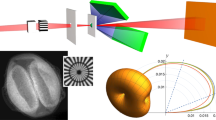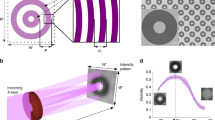Abstract
Recovering the three-dimensional (3D) properties of artificial or biological systems using low X-ray doses is challenging as most techniques are based on computing hundreds of two-dimensional (2D) projections. The requirement for a low X-ray dose also prevents single-shot 3D imaging using ultrafast X-ray sources. Here we show that computed stereo vision concepts can be applied to X-rays. Stereo vision is important in the field of machine vision and robotics. We reconstruct two X-ray stereo views from coherent diffraction patterns and compute a nanoscale 3D representation of the sample from disparity maps. Similarly to brain perception, computed stereo vision algorithms use constraints. We demonstrate that phase-contrast images relax the disparity constraints, allowing occulted features to be revealed. We also show that by using nanoparticles as labels we can extend the applicability of the technique to complex samples. Computed stereo X-ray imaging will find application at X-ray free-electron lasers, synchrotrons and laser-based sources, and in industrial and medical 3D diagnosis methods.
This is a preview of subscription content, access via your institution
Access options
Access Nature and 54 other Nature Portfolio journals
Get Nature+, our best-value online-access subscription
$29.99 / 30 days
cancel any time
Subscribe to this journal
Receive 12 print issues and online access
$209.00 per year
only $17.42 per issue
Buy this article
- Purchase on Springer Link
- Instant access to full article PDF
Prices may be subject to local taxes which are calculated during checkout




Similar content being viewed by others
Data availability
The data that support the plots within this paper and other findings of this study are available from the corresponding author on reasonable request.
References
Seibert, M. M. et al. Single mimivirus particles intercepted and imaged with an X-ray laser. Nature 470, 78–81 (2011).
Redecke, L. et al. Natively inhibited Trypanosoma brucei cathepsin B structure determined by using an X-ray laser. Science 339, 227–230 (2013).
Ravasio, A. et al. Single-shot diffractive imaging with a table-top femtosecond soft X-ray laser-harmonics source. Phys. Rev. Lett. 103, 028104 (2009).
Gauthier, D. et al. Single-shot femtosecond X-ray holography using extended references. Phys. Rev. Lett. 105, 093901 (2010).
Barty, A. et al. Ultrafast single-shot diffraction imaging of nanoscale dynamics. Nat. Photon. 2, 415–419 (2008).
Miao, J. et al. Beyond crystallography: diffractive imaging using coherent x-ray light sources. Science. 348, 530–535 (2015).
Nishino, Y., Takahashi, Y., Imamoto, N., Ishikawa, T. & Maeshima, K. Three-dimensional visualization of a human chromosome using coherent X-ray diffraction. Phys. Rev. Lett. 102, 018101 (2009).
Takahashi, Y. et al. Three-dimensional electron density mapping of shape-controlled nanoparticle by focused hard X-ray diffraction microscopy. Nano Lett. 10, 1922–1926 (2010).
Chapman, H. N. et al. High-resolution ab initio three-dimensional x-ray diffraction microscopy. J. Opt. Soc. Am. A 23, 1179–1200 (2006).
Howells, M. R. et al. An assessment of the resolution limitation due to radiation-damage in x-ray diffraction microscopy. J. Electron Spectrosc. Relat. Phenom. 170, 4–12 (2009).
Thibault, P. et al. High-resolution scanning x-ray diffraction microscopy. Science 321, 379–382 (2008).
Dierolf, M. et al. Ptychographic X-ray computed tomography at the nanoscale. Nature 467, 436–439 (2010).
Holler, M. et al. An instrument for 3D x-ray nano-imaging. Rev. Sci. Instrum. 83, 073703 (2012).
Chapman, H. N. et al. Femtosecond diffractive imaging with a soft-X-ray free-electron laser. Nat. Phys. 2, 839–843 (2006).
Ekeberg, T. et al. Three-dimensional reconstruction of the giant mimivirus particle with an X-ray free-electron laser. Phys. Rev. Lett. 114, 098102 (2015).
Thomson, E. Stereoscopic Roentgen pictures. Electr. Eng. 21, 256 (1896).
Andruleit, H., Geisen, M. & Stäger, S. Stereo-microscopy of coccolithophores-modern applications for imaging and morphological analysis. J. Nannoplankton Res. 28, 1–16 (2006).
Hoshino, M. et al. Development of an X-ray real-time stereo imaging technique using synchrotron radiation. J. Synchrot. Radiat. 18, 569–574 (2011).
Gleber, S.-C., Thieme, J., Chao, W. & Fischer, P. Stereo soft X-ray microscopy and elemental mapping of haematite and clay suspensions. J. Microsc. 235, 199–208 (2009).
Miao, J. et al. High resolution 3D X-ray diffraction microscopy. Phys. Rev. Lett. 89, 088303 (2002).
Schmidt, K. E. et al. Tomographic femtosecond X-ray diffractive imaging. Phys. Rev. Lett. 101, 115507 (2008).
Gallagher-Jones, M. et al. Macromolecular structures probed by combining single-shot free-electron laser diffraction with synchrotron coherent X-ray imaging. Nat. Commun. 5, 3798 (2014).
Wei, H. Fundamental limits of ‘ankylography’ due to dimensional deficiency. Nature 480, E1 (2011).
Wang, G., Yu, H., Cong, W. & Katsevich, A. Non-uniqueness and instability of ‘ankylography’. Nature 480, E2 (2011).
Thibault, P. Feasibility of 3D reconstructions from a single 2D diffraction measurement. Preprint at http://arXiv.org/abs/0909.1643v2 (2010).
Chen, C.-C. et al. Three-dimensional imaging of a phase object from a single sample orientation using an optical laser. Phys. Rev. B 84, 224104 (2011).
Xu, R. et al. Single-shot three-dimensional structure determination of nanocrystals with femtosecond X-ray free-electron laser pulses. Nat. Commun. 5, 4061 (2014).
Yabashi, M. & Tanaka, H. The next ten years of X-ray science. Nat. Photon. 11, 12–14 (2017).
Marr, D. & Poggio, T. Cooperative computation of stereo disparity. Science 194, 283–287 (1976).
Elser, V. Phase retrieval by iterated projections. J. Opt. Soc. Am. A 20, 40–55 (2003).
Furukawa, Y. & Hernández, C. Multi-view stereo: a tutorial. Found. Trends Comput. Graph. Vis. 9, 1–148 (2013).
Longo, E. et al. 3D imaging of theranostic nanoparticles in mice organs by means of x-ray phase contrast tomography. Proc. SPIE 10573, 105734I (2018).
Longo, E. et al. 3D map of theranostic nanoparticles distribution in mice brain and liver by means of X-ray phase contrast tomography. J. Instrum. 13, C01049 (2018).
Menk, R. H. et al. Gold nanoparticle labelling of cells is a sensitive method to investigate cell distribution and migration in animal models of human disease. Nanomed. Nanotechnol. Biol. Med. 7, 647–654 (2011).
Ortis, A., Rundo, F., Di Giore, G. & Battiato, S. Adaptive compression of stereoscopic images. In Proc. Int. Conf. Image Analysis and Processing 391–399 (Springer, 2013).
Lu, W. et al. Development of a hard X-ray split-and-delay line and performance simulations for two-color pump-probe experiments at the European XFEL. Rev. Sci. Instrum. 89, 063121 (2018).
Osaka, T. et al. Wavelength-tunable split-and-delay optical system for hard X-ray free-electron lasers. Opt. Express 24, 9187–9201 (2016).
Chen, B. et al. Multiple wavelength diffractive imaging. Phys. Rev. A 79, 023809 (2009).
Guizar-Sicairos, M., Thurman, S. T. & Fienup, J. R. Efficient subpixel image registration algorithms. Opt. Lett. 33, 156–158 (2008).
Amidror, I. Scattered data interpolation methods for electronic imaging systems: a survey. J. Electron. Imaging 11, 157–177 (2002).
Hartley, R. I. In defense of the eight-point algorithm. IEEE Trans. Pattern Anal. Mach. Intell. 19, 580–593 (1997).
Papadimitriou, D. V. & Dennis, T. J. Epipolar line estimation and rectification for stereo image pairs. IEEE Trans. Image Process. 5, 672–676 (1996).
Sobel, I. in Machine Vision for Three-Dimensional Sciences (ed. Freeman, H.) 376–379 (Academic Press, 1990).
Acknowledgements
We acknowledge financial support from the European Union through the Future and Emerging Technologies Open H2020: Volumetric medical X-ray imaging at extremely low dose (VOXEL) and the integrated initiative of the European laser research infrastructure (LASERLAB-EUROPE; grant agreement no. 654148). Support from the French ministry of research through the 2013 Agence Nationale de Recherche grant ‘NanoImagine’, 2014 ‘Ultrafast lensless imaging with plasmonic enhanced XUV generation’ and 2016 ‘High repetition rate laser for lensless imaging in the XUV’; from the Centre National de Compétences en Nanosciences research programme through the NanoscopiX grant; from the Laboratoire d’Excelence Physique Atoms Lumière Matière (ANR-10-LABX-0039-PALM), through grant ‘Plasmon-X’ and ‘High repetition rate laser harmonics in crystals’; and from the Action de Soutien à la Technologie et à la Recherche en Essonne programme through the ‘NanoLight’ grant are also acknowledged. We acknowledge financial support from the Deutsche Forschungsgemeinschaft, grant KO 3798/4-11, and from Lower Saxony through ‘Quanten- und Nanometrologie’, project NanoPhotonik. We acknowledge M. Kholodtsova for support on the CDI data treatment and discussions. We acknowledge A. Barty and Y. Nishino for data and discussions.
Author information
Authors and Affiliations
Contributions
J.D., R.C., J.H., W.B., B.I. and H.M. carried out the experiment. The samples were produced by F.F., L.D. and W.B. H.C. provided the 2D images of the pyramid. Simulations were performed by J.D. and R.C. Data analysis was performed by J.D., R.C., J.H., B.I., M.K., M.F., H.C., W.B. and H.M. W.B., M.K. and H.M. proposed the physical concept. All authors discussed the results and contributed to writing the manuscript.
Corresponding author
Ethics declarations
Competing interests
The authors declare no competing interests.
Additional information
Publisher’s note: Springer Nature remains neutral with regard to jurisdictional claims in published maps and institutional affiliations.
Supplementary information
Supplementary Information
Supplementary notes and figures.
Supplementary Video 1
Reconstruction of the cross.
Supplementary Video 2
Reconstruction of the nanopyramid.
Rights and permissions
About this article
Cite this article
Duarte, J., Cassin, R., Huijts, J. et al. Computed stereo lensless X-ray imaging. Nat. Photonics 13, 449–453 (2019). https://doi.org/10.1038/s41566-019-0419-1
Received:
Accepted:
Published:
Issue Date:
DOI: https://doi.org/10.1038/s41566-019-0419-1
This article is cited by
-
Material-specific high-resolution table-top extreme ultraviolet microscopy
Light: Science & Applications (2022)
-
Broadband coherent diffractive imaging
Nature Photonics (2020)



